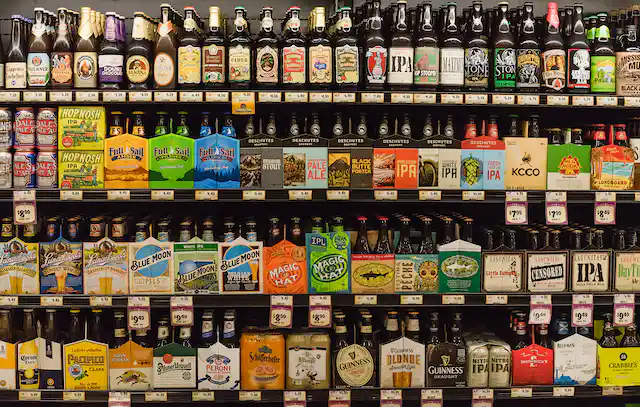Free Local Delivery over £25 within 10 miles from Shop in Hemel Hempstead | Free National Delivery over £60
Craft Beer Vs. Mass-Produced Beer: A Comparative Analysis

If you’ve ever found yourself standing in front of a beer aisle, unsure of what to choose, you’re not alone. The world of beer is vast and varied, with countless options to explore. Two major categories that often stand out are craft beer and mass-produced beer. In this article, we will conduct a comparative analysis of these two types of beer, delving into the brewing methods, flavor profiles, ingredients used, consumer experiences, and their overall impact.
Craft beer is the product of small-scale breweries that prioritize quality over quantity. These brewers take pride in their artistry and experimentation, resulting in unique and complex flavor profiles that push the boundaries of traditional brewing techniques. On the other hand, mass-produced beer is manufactured on a large scale by commercial breweries using standardized processes. While it may lack the artisanal touch of craft beer, mass-produced brews aim for consistency and accessibility.
By understanding the differences between craft beer and mass-produced beer, you can make more informed choices when selecting your next beverage. So sit back with a cold one as we dive into this fascinating world where taste meets tradition!
Brewing Methods: Understanding the Process Behind Craft Beer and Mass-Produced Beer
Do you ever wonder how craft beer and mass-produced beer are made? Understanding brewing techniques is key to appreciating the differences between these two types of beer. Craft beer is typically brewed using traditional methods that prioritize quality and flavor. The fermentation process in craft brewing involves the use of specific yeast strains, carefully controlled temperatures, and longer aging periods. This allows for a more complex flavor profile to develop, resulting in unique and distinct tastes. On the other hand, mass-produced beer follows a more streamlined approach with shorter fermentation times and the use of commercial yeast strains. This often leads to a lighter, less complex flavor profile. Now let’s explore the unique tastes of craft beer and mass-produced beer by delving into their flavor profiles…
Flavor Profiles: Exploring the Unique Tastes of Craft Beer and Mass-Produced Beer
Explore the distinct and tantalizing flavor profiles that will transport your taste buds to a world of unique and exquisite tastes. Craft beer, with its emphasis on quality and innovation, offers an array of flavors that are truly one-of-a-kind. From hoppy IPAs bursting with citrusy notes to rich stouts with hints of chocolate and coffee, craft beer provides a sensory experience like no other. Each sip takes you on a journey of complexity and depth, leaving you craving more. On the other hand, mass-produced beer often lacks the same level of creativity and complexity in its flavor profile. While it may offer a refreshing taste, it often falls short when it comes to delivering unique flavors that truly excite the palate. As we delve into the differences between craft beer and mass-produced beer’s ingredients, we’ll uncover even more reasons why craft beer reigns supreme in terms of taste diversity and quality craftsmanship.
Ingredients: Uncovering the Differences in the Ingredients Used in Craft Beer and Mass-Produced Beer
Unveiling the contrasting ingredients in craft beer and mass-produced beer reveals a bountiful array of flavors that captivate the senses. Craft beer ingredients are carefully selected, often sourced locally, and chosen for their quality and uniqueness. Brewers pride themselves on using high-quality malts, hops, yeast, and water to create distinctive flavor profiles that cannot be replicated. On the other hand, mass-produced beer ingredients tend to prioritize efficiency and cost-effectiveness over flavor complexity. They often rely on cheaper malt substitutes, hop extracts, adjuncts like corn or rice, and standardized yeast strains. This results in a more uniform taste that lacks the depth found in craft beers. By focusing on the unique ingredients used in each type of beer, we gain insight into how these choices shape the overall consumer experience: comparing the atmosphere and culture surrounding craft beer and mass-produced beer.
Consumer Experience: Comparing the Atmosphere and Culture Surrounding Craft Beer and Mass-Produced Beer
Immerse yourself in the distinct atmospheres and cultures surrounding craft beer and mass-produced beer to truly appreciate their unique experiences. When it comes to atmosphere, craft breweries often offer a cozy, intimate setting where you can chat with fellow beer enthusiasts and even meet the brewers themselves. The ambiance is typically laid-back and welcoming, making it easy to strike up conversations about tasting notes or brewing techniques. In contrast, mass-produced beer is often consumed in more commercial settings like sports bars or nightclubs, where the focus may be more on quantity rather than quality.
Another key difference between craft beer and mass-produced beer is the emphasis on local versus global. Craft breweries tend to prioritize using locally sourced ingredients whenever possible, resulting in brews that showcase regional flavors and support the local economy. On the other hand, mass-produced beers are often made with standardized ingredients sourced from all over the world to maintain consistency across global markets.
As you delve into this comparison of atmospheres and cultures surrounding craft beer and mass-produced beer, it becomes clear that each offers a unique experience for consumers. Now let’s transition into analyzing the economic and environmental effects of these two types of beers without skipping a beat.
Growth and Impact: Analyzing the Economic and Environmental Effects of Craft Beer and Mass-Produced Beer
Take a moment to consider the impact that craft beer and mass-produced beer have on the economy and environment, and how your choices as a consumer can make a difference. Craft beer has experienced significant economic growth in recent years, contributing to job creation and local economies. With its focus on quality ingredients and unique flavors, craft breweries have become an integral part of the food and beverage industry. On the other hand, mass-produced beer dominates the market with its large-scale production capabilities and lower price points. However, this comes at a cost to environmental sustainability. The energy-intensive processes used by mass-produced breweries result in higher carbon emissions and water consumption compared to their craft counterparts. By choosing craft beer, consumers can support local businesses while also promoting more sustainable practices within the brewing industry.





